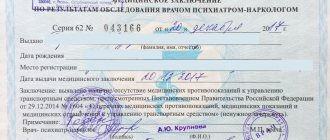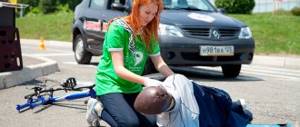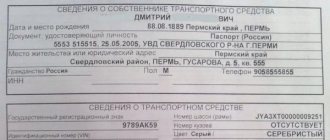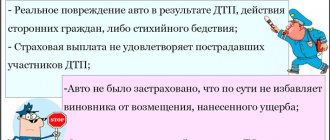I would like to begin this note with the fact that, contrary to popular belief, the legislation does not provide for the possibility of appealing the conclusion of a forensic medical examination. However, this does not mean that if you do not agree with the expert’s conclusion, then nothing can be done. There are several ways to prove that such a conclusion is incorrect, although this is not a “forensic appeal” in the truest sense of the word, which we will discuss below.
It is possible to appeal an expert's opinion, as well as a court ruling ordering an examination, only together with a verdict or other court decision in the manner prescribed by law.
This is due to the fact that, in accordance with Article 55 of the Civil Procedure Code of the Russian Federation (hereinafter referred to as the Code of Civil Procedure of the Russian Federation) and Article 74 of the Criminal Procedure Code of the Russian Federation (hereinafter referred to as the Code of Criminal Procedure of the Russian Federation), the conclusion and/or testimony of an expert are evidence in the case. Evidence obtained in violation of legal requirements is considered inadmissible and cannot be used as the basis for a court decision. They are considered unacceptable if during their collection or securing the order established by law was violated.
Courts leave without consideration the applicants' demands to recognize forensic medical examinations as unfounded and illegal, separately from the review of a criminal or civil case.
Thus, by appeal resolution No. 22-1372/15 of December 27, 2015, the Tambov Regional Court upheld the complaint of I.A. Putilov. without satisfaction. The applicant asked to recognize the additional forensic medical examination as illegal due to a violation of the criminal procedural law and to exclude it from evidence in the criminal case. This complaint was left without consideration and returned to I.A. Putilov. with an explanation of his right to appeal to the court to review the sentence in cassation.
In the appeal, the applicant indicated that his application in the court of first instance was not considered by the court; a statement was made about the possibility of appealing the verdict. Also Putilov I.A. indicated that the examination was carried out without a resolution ordering it, and therefore should be excluded from the evidence in the case. In essence, the applicant disputed the evidence on which the court's conviction was based.
It is necessary to take into account the explanation of the Plenum of the Supreme Court of the Russian Federation “On the practice of courts considering complaints in accordance with Article 125 of the Criminal Procedure Code of the Russian Federation” No. 1 of February 10, 2009, where paragraph 9 states that the criminal case in which the complaint is filed , if it has already been sent to the court for consideration on the merits or a verdict has been passed on the case, then the judge has the right to accept such a complaint for consideration only if its subject is decisions and/or actions, as well as inaction, of officials affecting the rights and legitimate interests of the applicants and who are not participants in the proceedings in this criminal proceeding.
The applicant's complaint was filed in a criminal case where a sentence had already been pronounced. Consequently, based on the Resolution of the Plenum of the Supreme Court of the Russian Federation No. 1 of February 10, 2009, there were no violations on the part of the court in leaving the complaint without consideration. The court explained to the applicant that he retained the right to have the forensic medical examination declared illegal by filing a cassation appeal against the court verdict, in the manner prescribed by Article 401.2 of the Criminal Procedure Code of the Russian Federation.
It is worth noting that the Civil Procedure Code also does not provide for the possibility of filing a private complaint against the ruling on the appointment of a forensic medical examination in terms of non-compliance with the procedure for its appointment, determining the range of issues to be posed to the expert, the court’s choice of an expert institution, etc. Forensic expert opinions cannot be appealed in an appellate court separately from the court decision. A similar approach can be seen in civil trials, for example, in the Determination of the Orenburg Regional Court No. 33-9140/2015.
The concept of conducting a forensic medical examination
This concept includes a list of highly qualified actions performed that will help determine the severity of harm caused to participants in an accident. It is usually carried out to determine the circumstances of a person’s death. Only professionals with certain knowledge and experience in such matters are authorized to perform this procedure. After completing the procedure, a test result certified by specialists is issued, which can be used as an argument when hearing the case in court.
If a third party receives moderate damage, the party found guilty will bear administrative liability. The presence of serious injuries that result in disability or death of a person may result in criminal prosecution.
Types of forensic medical examination
Professionals divide forensic examination into several aspects, which include:
- Test object,
- Type and complexity of the procedure.
According to the first criterion, this procedure can be performed in relation to a corpse or a living object.
According to the second, forensic medical examination is divided into the following types:
- Complex,
- Additional,
- Repeated,
- Commission.
Such actions can be carried out by government agencies or independent specialists, but in the latter case the organization must have permission to carry out this type of activity. A complex type of such examination is carried out by several specialists. Professionals from various fields in the medical field are involved in this procedure.
IMPORTANT !!! If, after completing it, controversial issues remain, a re-examination is scheduled. During a commission examination, members of the commission are involved in conducting the study, for which experienced specialists in various fields of medical practice are selected. Each physician must sign the final report. When the opinion of one of the invited specialists does not coincide with the opinion of the other experts, he indicates his explanation in the conclusion.
A medical examination can be performed at the request of one or both parties. In fact, if an ambulance goes to the scene of an accident, a medical examination will be ordered. Many drivers are interested in questions about whether a forensic examination is needed after an accident? How is it carried out? Deadlines? What is it for? All these questions will be answered below.
Who orders a medical examination after an accident?
The following persons are identified who have the authority to order a forensic medical examination after a traffic accident has occurred:
- Investigator.
- Interrogator.
- Judge.
- Prosecutor.
In this case, the judge signs the ruling on the basis of which the examination is carried out, and all other persons issue a decision to conduct the research.
If there is a need to obtain a truly correct result of a forensic medical examination in an accident, to establish the severity of injuries received, then the study should be carried out after the victim has fully recovered. This is necessary in order to obtain all medical documentation that was collected during the course of treatment.
A forensic medical examination after an accident is mandatory if the cause of death of the person involved in the incident, harm to human health, or the mental state of the victim is established. In the latter case, we are talking about his sanity and adequacy after an accident.
If you have doubts about the correctness of the forensic medical examination after an accident, you can get free legal advice online by contacting professional lawyers:
Thank you, your feedback is important to us
22.12.2017
★★☆☆☆
2 5 1
“This is a non-existent number”
— Anatoly
How should a medical examination be carried out?
To conduct a medical examination, a corresponding resolution from the authorized body is required. It can be an inquiry officer, an investigator or a judge, as well as other authorities.
The decision to conduct this examination must contain:
- The name of the case according to which the medical examination is being carried out,
- The official party initiating the medical examination
- The name of the organization that will perform the forensic medical examination,
- Information about the testing object,
- Sample information.
All information received will be carefully processed, after which a written conclusion on the test results will be issued.
This document states:
- Full names of the experts who carried out the research work,
- Information about the object of examination,
- List of studies carried out,
- Answers to pressing questions posed by an authorized person.
If there are inaccuracies or controversial issues based on the results of the examination, a repeat examination is ordered. If it is necessary to clarify certain nuances, the expert may be summoned to court as a witness. For drawing up a false or grossly inaccurate conclusion, an expert may be subject to criminal prosecution.
General information
According to the generally accepted definition, a forensic medical examination after an accident is a set of activities aimed at establishing the circumstances of the incident and searching for evidence that will later be presented in court. The medical examination is one of the medical examinations. This procedure should be distinguished from a medical examination, since they are largely similar. The SME is carried out exclusively by order of the investigative authorities.
In what cases is it prescribed
An expert assessment may be required in case of accidents in which there are one or more victims.
Moreover, this applies to injured persons with any bodily injuries received in a road accident. As a rule, for minor injuries, only a medical examination is required, which can be carried out on a voluntary basis or upon a referral from the traffic police. An examination is more often prescribed in case of road accidents in which the participants suffered serious damage to their health. An emergency medical technician is also required in case of fatal incidents.
Who performs the procedure
The SME can be carried out by government or private experts. The first option is common if the study is ordered by an authorized person. Then the participants in the accident are not required to pay for the procedure. The services of private bureaus are usually used in situations where the EMS is carried out voluntarily. In any case, only persons with the appropriate license can carry out assessment activities.
What issues are being resolved
When considering the need to conduct a forensic examination, it is necessary to determine the subject and objectives of the forensic examination of the circumstances of the accident. The main purpose of such a procedure is to assist in the investigation of the incident. In the future, the results of the SME are evidence of the guilt of a particular participant in the accident.
The main tasks include:
- Identification of injuries and other damage, determination of their number and location;
- Recording information about bodily damage caused;
- Determination of factors that provoked a particular injury;
- Assessment of severity;
- Identification of the sequence of damage;
- Determination of causes of death and details of the fatal incident;
- Detection of signs of alcohol or drug intoxication in the body of the accident participants.
Attention! The full list of tasks for forensic examination of road accidents is very long. It depends on the nature of the incident, the condition of the injured persons and many other aspects.
Deadlines provided for by law
Due to the subtlety of the required work and the variety of methods for conducting the examination, the legislation does not establish deadlines for carrying out this procedure. Tests can take quite a long time, so parties should be patient and wait for the results.
Sometimes the tests take several months. The timing directly depends on the complexity of the task assigned to the expert. In the event of a death of a third party, only a couple of days are allocated to conduct the study. If the examination is carried out in a private institution, then the deadlines for execution will be specified in the agreement between the customer and the contractor. Failure to comply with the terms of the contract will be grounds for initiating legal proceedings for violations specified in the contract.
IMPORTANT !!! When a pedestrian is injured as a result of an accident, a medical examination is mandatory. Usually, a criminal case is initiated, and the examination procedure itself is initiated by the inquiry officer or investigator. If the pedestrian suffered minor injuries and drove home after the accident, he may be called to undergo a forensic examination if necessary. There are cases when a pedestrian initially feels great, does not feel pain and insists on the need to leave for his business.
In this case, he may be released by law enforcement agencies. If a pedestrian feels unwell during the day or at night, he can go to a medical facility for medical assistance. This fact must be recorded, then the investigator will order a forensic medical examination, as a result of which the injured party can claim compensation for treatment losses.
To conduct a forensic medical examination, it is necessary to present to the expert all documents received at the medical institutions where the injured party received assistance. If all necessary documents are not available, the examination will not be carried out. It is important to note that the conclusion issued by the experts cannot be appealed, but in some cases it is possible to prescribe repeated or additional testing.
Circumstances of the incident
An accident must involve parties such as two or more cars, vehicles, or a complex incident that includes not only cars, but also pedestrians. In addition, only one vehicle can be a party if it overturns, collides with an obstacle, or is damaged as a result of other similar situations. Even the pedestrian himself can suffer if he is hit by a vehicle.
The described cases almost always indicate that there are people who were injured as a result of a traffic accident or even died. Everything will depend on the circumstances and the severity of the injuries received.
Before ordering an examination, all the events of the event must be established and the scene of the incident must be inspected with the participation of an expert auto technician. In addition to the area where the accident occurred, the car itself is carefully inspected to identify damage, foreign objects and other factors that were the causes.
When the death of a corpse occurs, it is examined, after which it is taken to the morgue. If there is no death, then assistance is provided to the victims until the ambulance arrives. All these initial measures are necessary in order to clearly and more correctly record the injuries and traumatic objects.
What aspects can be discovered during such an examination?
After conducting all the necessary tests, the expert will be able to answer the following questions:
- Determination of the impact force that caused certain damage,
- Presence, location on the body and duration of existing injuries,
- Body position during an accident,
- The presence of alcohol, drugs, medications or psychotropic substances in the blood of all participants in the accident,
- The procedure for causing damage, because the victim can cause damage to himself in order to receive a larger amount of compensation,
- Determining the vehicle that may cause injury to the victim,
- In the event of a fatality for one of the parties to the accident, the expert will be able to determine the impact that resulted in death.
Features of the examination of the victim
The SME procedure itself has many nuances, and the order in which it is carried out depends on who is the object of the work - a living person, a corpse or things. Since the expert himself is not at the scene of the accident, he needs all documentary information to begin work. They are contained in the descriptive part of the resolution on the emergency medical investigation, and must be described in such detail and clearly that the expert has a clear picture of the incident.
Data on the initial state of health, documented immediately after the accident, is contained in the medical history, including all the results of tests and examinations performed. If the expert considers it necessary to begin his work before the person is finally cured, he can, by mutual agreement with him, begin the study without waiting for this. It must be borne in mind that in this case there is a possibility of challenging the conclusions of the examination by officials.
So, if a person who was injured during an accident is being examined, the expert must answer the following questions in his conclusion:
- what is the nature of the damage and injury;
- their location on the body, height and number;
- what is the extent of these damages;
- what part of the vehicle caused them;
- when the injuries occurred;
- presence of alcohol or drug intoxication.
Based on the conclusions of the expert (or a group of experts, if a commission or comprehensive examination is appointed), a claim for compensation for losses to the victim will be based, and a referral for a medical and social study to assign a disability group will be possible.
When is a forensic examination performed?
A medical examination is carried out upon completion of treatment of the victim. This will allow you to immediately receive a complete package of documents confirming the real condition of the injured person. The expert will be able to accurately assess the extent of damage, which will be reflected in the examination report. In addition, there are some situations that make a medical examination mandatory.
These include:
- A situation where it is necessary to find out the cause of death of the victim,
- Circumstances forcing the determination of the extent of damage,
- Moments when information about the age of the participants in the incident is important for the court,
- Aspects that suggest the inadequacy or insanity of the person responsible for the accident.
When a forensic medical examination is not possible in an accident
There are cases when SMEs are not carried out. These do not include the wishes of the victim or those responsible for the traffic accident. This suggests that the will of the person plays a significant role. The same applies to the moment when a person’s identity has not been established and his place of residence has not even been established. The study is also impossible in the event of the occurrence of such cadaveric phenomena that occurred as a result of a severe accident or for a long time after death, which do not allow making an unambiguous conclusion or conducting any research at all with reliable accuracy.
Conducting a forensic examination is very important to establish the severity of bodily injuries, as well as the causes of death of a person as a result of an accident. It will be enough to make an appropriate decision or determination, on the basis of which specialists, after full correction of the victim or the perpetrator, make a conclusion where the conclusions are written.
More detailed and free legal advice can be obtained from experienced motor vehicle lawyers:
Save
Save
Save
What is forbidden to do during the examination?
To find out the circumstances of the accident, it is necessary to conduct a forensic examination. During its implementation, it is prohibited to use methods that could destroy evidence or aggravate the victim’s condition.
Among these methods it is worth noting:
- Deception or exploitation of the victim's ignorance,
- Medicines or diagnostic methods that have not been certified or are in preparation,
- Threats against the victim,
- Innovative operating procedures that have not undergone the necessary testing.
What directions generally exist?
Forensic examination is carried out in the following cases:
- Checking your current health status.
- Forensic examination of beatings to record injuries.
- Establishment of harm caused to health.
- Checking the quality of medical care, identifying medical errors.
- Determination of causes of death.
- Establishing the method of murder.
- Check after an accident to record injuries.
- Genetic research.
- Other situations in which it is impossible to do without the support of specialists.
Cost of forensic examination
Most road accident participants are interested in the question of whether a forensic medical examination should be paid or free. This procedure is carried out in different ways. The cost of the examination depends on the purpose of obtaining data. If the request is sent by official bodies, then the amount of payment for the procedure may be recovered from the guilty party. Most drivers, trying to prove that they are right, contact private organizations personally.
ATTENTION !!! The cost of such an examination is quite high, which makes its return on investment doubtful. The cost of this procedure can vary from 40,000 to 60,000 rubles. Therefore, before ordering this service, you should consult with a lawyer and calculate all possible options.
If the offense is serious, then the official authorities will be forced to order a forensic examination. Otherwise, you can spend a lot of money and the results will be disappointing.
Expertise “on the principle of discretion”
The reason for this note was a case from practice, which once again made me think about the role of medical examination in the judicial process.
It is no secret that over the past decades the quality of medical examinations has decreased. This is recognized by both the Prosecutor General and authoritative scientists in the field of forensic medicine, who, when publishing the results of their research, note the presence of defects of varying degrees of significance in almost 90% of expert reports and opinions1.
Let's consider how erroneous conclusions in the expert's conclusion are related to the regulatory legal act regulating the examination - in particular, with the Medical criteria for determining the severity of harm caused to human health, approved by Order of the Ministry of Health and Social Development of the Russian Federation of April 24, 2008 No. 194n (hereinafter - Medical criteria).
Here is an example from my practice. As a result of a car hitting a pedestrian, he suffered injuries to the chest and left knee joint. The forensic examination concluded that there was a closed rib fracture without displacement of the fragments, a closed fracture of the lateral condyle of the left tibia, as well as an abrasion and bruise in the area of the right knee joint.
In total, three medical examinations were carried out in the case, the conclusions of which turned out to be contradictory. They had one thing in common: the experts classified a closed fracture of the lateral condyle of the tibia as an injury that caused serious harm to health, based on a significant permanent loss of general working capacity of more than a third. However, they did not refer to a specific point in the Medical Criteria.
The lack of a logical basis for the conclusion about the severity of harm to health forced the specialist and lawyer who participated in the judicial investigation to carefully study the Rules for determining the severity of harm caused to human health (approved by Decree of the Government of the Russian Federation of August 17, 2007 No. 522, hereinafter referred to as the Rules) and Medical criteria .
In both of these documents, harm caused to human health is understood as a violation of the anatomical integrity and physiological function of human organs and tissues as a result of exposure to physical, chemical, biological and mental environmental factors. I would like to emphasize that, in accordance with this definition, violations of not only anatomical integrity, but also physiological function are subject to examination within the framework of a forensic medical examination.
The Medical Criteria indicate, in particular, that harm caused to human health is determined depending on the degree of severity (severe, moderate, mild) on the basis of the qualifying characteristics provided for in paragraph 4 of the Rules, and in accordance with the Medical Criteria.
According to clause 4 of the Rules, the qualifying signs of grave harm are:
- life-threatening harm;
- loss of vision, speech, hearing or any organ or loss of organ functions;
- abortion;
- mental disorder;
- drug addiction or substance abuse;
- permanent facial disfigurement;
- significant permanent loss of general ability to work by at least one third;
- complete loss of professional ability to work.
In our case, the experts were guided by the qualifying feature “significant persistent loss of general ability to work by at least one third.”
Clause 6.11 of the Medical Criteria states that “serious harm to health, causing a significant permanent loss of general working capacity of at least one third, regardless of the outcome and the provision (failure to provide) medical care, includes the following injuries: ... including open or closed fracture of the bones that make up the knee joint, with the exception of the patella.”
I would like to draw attention to the contradiction of the main message - “regardless of the outcome and provision of medical care” - when determining harm to health contained in the Medical Criteria. After all, both the Rules and the Medical Criteria clearly indicate the need for mandatory research not only of violations of anatomical integrity, but also of physiological function. This is, of course, the correct approach, since in practice certain injuries often end in healing without medical intervention, but the degree of restoration of the impaired function can vary dramatically - from disability with complete loss of ability to work to minor functional impairments, sometimes even invisible to a non-specialist in the field medicine.
In this part, the provisions of the Medical Criteria allow, in my opinion, the use of the subjunctive mood in expert practice, which is unacceptable. How can you categorically evaluate something that can happen but has not yet happened? Based on this, it can be stated that the Medical Criteria have provisions that allow experts to formulate conclusions without sufficient justification based on the principle of discretion and take as a basis the interpretation of terms outside the framework of the regulatory legal act.
Let's move on to a specific injury (in our case, it is a closed fracture of the lateral condyle of the left tibia), named in paragraph 6.11.7 “Open or closed fracture of the bones that make up the knee joint, with the exception of the patella” of the Medical Criteria). The absence of a listing of specific fractures of specific bones in this paragraph makes it possible for it to be interpreted differently in practice.
Thus, in the comments to the Rules and Medical Criteria, the authors unreasonably, in my opinion, explain2 that a fracture of the bones that make up the knee joint, with the exception of the patella, must be understood as a fracture of at least one of these bones, and they do not justify this logically in any way. It seems that the meaning of clause 6.11.7 should be understood as a fracture of at least two bones that make up the knee joint, i.e. fractures of the femur and tibia. Clause 6.11.2 “Open or closed fracture of the bones that make up the elbow joint” of the Medical Criteria is formulated similarly.
In cases where even one fracture of one of the bones or cartilages that form a complex anatomical formation leads to serious harm to health, the Medical Criteria clearly lists the corresponding injuries - for example, in paragraph 6.1.5 “Fracture of the cartilages of the larynx: thyroid or cricoid, or arytenoid, or epiglottis, or corniculate, or tracheal cartilages" or clause 6.11.1 "Open or closed fracture of the humerus: intra-articular (humeral head) or periarticular (anatomical neck, sub- and transtubercular), or surgical neck, or humeral diaphysis bones".
I believe that when one of the bones that make up the knee joint is fractured, it is necessary to be guided by another qualifying feature - the duration of the health disorder. If the impaired function has not been examined, then the expert must take into account clause 27 of the Medical Criteria and point out the impossibility of determining the severity of harm to health using such a qualifying feature as a significant permanent loss of general ability to work by more than one third.
In conclusion, I note that when conducting forensic medical examinations to determine the severity of harm caused to human health, experts are forced to be guided by the incorrect imperative to determine the severity of harm before the outcome of the post-traumatic state, which, of course, in some cases leads to a biased assessment of the severity of harm to health. Medical criteria contain provisions that allow experts to formulate conclusions without sufficient justification - based on the principle of discretion - and to take as a basis the interpretation of terms outside the framework of the normative legal act.
In this regard, I consider it necessary to make changes to the Medical Criteria that provide wording that excludes double interpretation, and thus eliminate the contradiction that allows assessment of the severity of harm to health based on the qualifying criterion “significant persistent loss of general working capacity of more than one third” without examining the impaired function organ or system.
1 Popov V. Journal “Forensic Medical Examination” No. 3, 2013. Data from the analysis of 303 conclusions and reports are presented, in 275 of which errors were found in forensic activities.
2 Vladimir Klevno. Comments on regulatory legal documents governing the procedure for determining the severity of harm caused to human health. 2008










